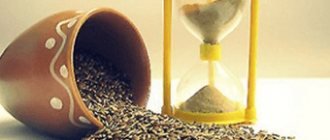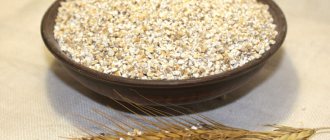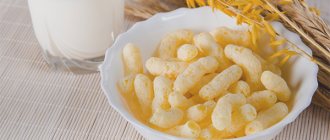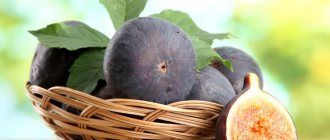General information
The first mentions of kohlrabi were recorded in the 16th century AD. The Romans called the vegetable “caulorapa,” which translated means “stem turnip.” In the old days, kohlrabi was considered a weed crop, which is why it was consumed only by the poor. The plant gained real popularity only in the 17th century, when German peasants began growing the vegetable.
Content:
- General information
- Chemical composition
- Beneficial features
- Features of cultivation
- Use in folk medicine
- Application in cosmetology
- Use in cooking
- Conclusion
The homeland of stem cabbage is the island of Sicily, from where it spread throughout the continent. Today, kohlrabi is grown in almost all countries of Europe, America and Central Asia. In addition, due to its cold-resistant properties, the plant is cultivated in the northern regions of Russia (Sakhalin and Kamchatka).
In appearance, the vegetable resembles a round rutabaga, and in taste, it resembles the core of white cabbage. However, unlike its “brothers”, it has a more juicy sweet pulp containing about 90% water. The diameter of the average kohlrabi stalks is 7-10 cm, and the weight is 200-600 g. The color varies from light green to dark purple.
The vegetable is classified as an early-ripening crop, since its growing season is only 2-2.5 months. In view of this, in one season it is possible to harvest from 2 to 3 cabbage crops. Interestingly, early varieties of kohlrabi are unsuitable for long-term storage (as they have delicate flesh). Later types of cabbage have a denser core, which increases their shelf life.
Root vegetables are stored in the basement, first sprinkled with moistened sand.
Chemical composition
Kohlrabi is classified as a dietary product, since 100 g of its pulp contains no more than 44 kcal. However, despite the low calorie content, the vegetable has high nutritional value (due to the content of vitamins, minerals, saccharides, antibacterial substances, dietary fiber, pectins).
The leaves of the cabbage turnip contain 2 times more nutrients than the stem fruit.
Nutritional value of kohlrabi
| Name | Substance content in 100 grams of stem fruit, grams |
| Water | 86,2 |
| Carbohydrates | 7,9 |
| Squirrels | 2,8 |
| Alimentary fiber | 1,7 |
| Ash | 1,2 |
| Fats | 0,1 |
Chemical composition of kohlrabi
| Name | Nutrient content per 100 grams of raw product, milligrams |
| Vitamins | |
| Ascorbic acid (C) | 52 |
| Niacin (PP) | 1,2 |
| Tocopherol (E) | 0,2 |
| Pantothenate (B5) | 0,17 |
| Pyridoxine (B6) | 0,17 |
| Thiamine (B1) | 0,06 |
| Riboflavin (B2) | 0,05 |
| Folate (B9) | 0,018 |
| Beta carotene (A) | 0,008 |
| Macronutrients | |
| Potassium | 370 |
| Phosphorus | 50 |
| Calcium | 46 |
| Magnesium | 30 |
| Sodium | 10 |
| Microelements | |
| Iron | 0,6 |
| Manganese | 0,14 |
| Copper | 0,13 |
| Zinc | 0,03 |
| Selenium | 0,0007 |
Kohlrabi pulp contains natural antioxidants with antitumor and anticarcinogenic activity (sulforaphane, sinegrin, indole-3-carbinol).
Beneficial features
Cabbage turnips, due to their low calorie content and high nutritional value, are successfully used in dietetics.
Beneficial features:
- Accelerates the removal of excess fluid from the body, reduces the likelihood of edema (potassium).
- Improves the condition of the oral cavity (the fibers massage the gums, and the juice provides natural sanitation to the pharynx).
- Normalizes the frequency of muscle and heart contractions (sodium, potassium, magnesium).
- Strengthens the vascular wall, increases the elasticity of veins and arteries, reduces blood viscosity (vitamin C).
- Improves lipid metabolism (fiber and pectin fibers).
- Increases the acidity of gastric juice (organic acids).
- Strengthens intestinal motility, accelerates the elimination of toxic waste (ballast substances).
- Slows down the process of carbohydrate absorption, prevents the development of insulin resistance, and prevents the transformation of saccharides into adipose tissue (tartanic acid).
- Suppresses the growth of pathogenic bacteria that cause stomach ulcers and caries (antibacterial substance sulforaphane).
- Activates natural anti-cancer immunity (indole-3-carbinol and sinegrin).
- Stabilizes blood pressure (magnesium).
- Improves psycho-emotional background (vitamins B and C).

Contraindications to consumption of kohlrabi cabbage (raw):
- peptic ulcer;
- acute form of pancreatitis;
- hyperacid gastritis;
- hypotension;
- individual intolerance.
If flatulence occurs due to the consumption of vegetables, the diet is enriched with spices (dill, fennel, cardamom, cloves). In addition, bacteria (probiotics) are introduced into the daily menu, since gas formation in 90% of cases signals a weakening of the microflora.
Contraindications for eating kohlrabi cabbage

Kohlrabi should be consumed with caution in the following situations:
- Increased stomach acidity
. In this case, problems with heartburn may arise, and if you continue to consume the vegetable, pancreatitis may occur. - Drinking milk
. When combined with kohlrabi, it may cause diarrhea. - Pregnancy
. Kohlrabi per 100 grams contains 13 mg of purines, the abuse of which can lead to intestinal problems. - Acute pancreatitis
. May cause worsening of the condition. - Industrially produced kohlrabi
. This vegetable absorbs all substances very well, so producers take advantage of this to “feed” it in the garden with fertilizers that are not always permitted. Pay attention to the place where the product was grown, as well as the manufacturer itself, if possible, look at reviews on the Internet.
Attention! Cases of individual intolerance are extremely rare, however, if the first symptoms appear, you should stop using the product and consult a doctor.
Features of cultivation
Kohlrabi cabbage is less demanding on growing conditions than other cruciferous plants. In addition, it is resistant to cold and gets along well with vegetable crops. The optimal temperature for its growth is 15-18 degrees. If this indicator drops below +6 degrees (within 5 days), young plants stretch into stems (stems are not formed).
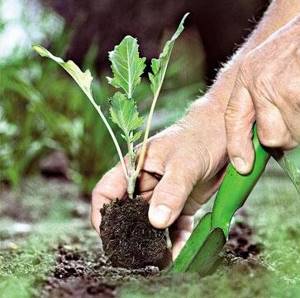
Cabbage turnip prefers slightly acidic and neutral soils (pH 5.5-6.8). In addition, for successful cultivation of the vegetable, it is important to maintain constant soil moisture (due to the shallow root system). With a lack of liquid, the spherical stems become woody and then covered with small cracks.
Kohlrabi is grown both by seedlings and by sowing. To obtain an early harvest (in May), the grains are planted in boxes at the end of February. To collect vegetables in the summer, the seeds are placed in peat cups in mid-April.
To get an autumn harvest, the crop is planted in a greenhouse in early July. After germination, the containers are transferred to a cool place (10-15 degrees). Seedlings are planted in open ground at the stage of 5-6 true leaves (pre-hardened). The duration of seed growth (from sowing to picking) is 35-45 days.
Remember, before planting a cruciferous crop, it is important to thoroughly prepare the soil. To do this, the soil is dug up (without turning the layer), and then nitrogen fertilizers are applied (manure compost is possible).
The best predecessors for kohlrabi are tomatoes, onions, potatoes, pumpkin, legumes and grain (winter) crops. After planting the plants (at a distance of 20 cm from each other), the soil is compacted and watered abundantly.
Late varieties of kohlrabi are sown in open ground (in mid-May). In this case, each grain is placed in a separate hole 2 cm deep. After the appearance of the 2nd leaf, the seedlings are thinned out.
Caring for cabbage comes down to regular watering, loosening the soil and weeding. In addition, the plant is fed with fertilizers twice during the growing season: 2 weeks after planting - with fermented organic matter, and after 20 days with a solution of superphosphate with potassium.
The harvest date is determined by the stalk: if a scratch remains on the “turnip” after rubbing with a fingernail, the stalk is ripe.
Use in folk medicine
To prepare medicinal potions, the juice and tops of fresh stem fruits are used. Remember, infusions, decoctions, and cabbage turnip cocktails cannot replace full-fledged drug therapy; they are used as an aid in the fight against the disease.
Compositions based on kohlrabi are effective in the treatment of tuberculosis, bronchial asthma, vitamin deficiency, influenza, neurosis, non-healing weeping wounds, anemia, gingivitis, stomatitis, hypoacid gastritis.
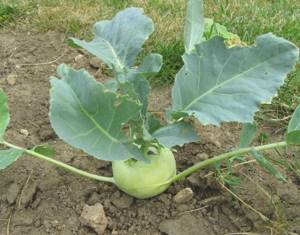
Traditional recipes:
- A remedy for reducing cough syndrome (for bronchitis, asthma, tuberculosis). Kohlrabi tops are used as the active ingredient. To prepare the medicine you will need 400 ml of water and 60 g of fresh cabbage leaves. These components are boiled for 20 minutes over medium heat, after which the mixture is cooled and filtered. In case of exacerbation of the disease, the composition is taken 5 times a day, 150 ml.
- Anti-inflammatory drink with honey. The main ingredient of the healing mixture is freshly squeezed kohlrabi juice. To create a drink, it is better to choose medium-sized stem fruits. After this, the stalks are crushed on a grater, transferred to a piece of gauze and the juice is squeezed out. Before use, add liquid honey (10 ml).
The drink is taken three times a day, 70-100 ml (warm). If well tolerated, the single dose is increased to 200 ml (gradually). The course of treatment is 30-60 days. After 4-6 months, cabbage therapy is repeated (if necessary).
Fresh kohlrabi juice is used for colds, hypoacid gastritis (reduced secretion of gastric juice), hepatitis, cholecystitis, anemia, insomnia, and menopausal neuroses.
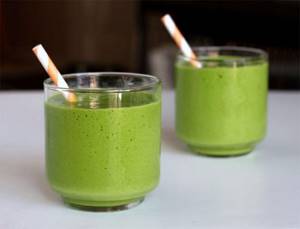
In case of exacerbation of pancreatitis, gastritis (hyperacid) or ulcers, it is better to avoid taking this drug.
- Nutrient mixture to strengthen the heart muscle. Ingredients: kohlrabi (220 g), cucumbers (120 g), cilantro (10 g). Squeeze juice from vegetables, combine with chopped herbs. Take 100 ml three times a day. Duration of treatment – 1 month.
- Vitamin cocktail for immunity. To create the potion you will need 150 ml of kohlrabi juice, 100 ml of carrot juice, 50 ml of beet juice, 50 ml of sauerkraut brine (white cabbage). Combine these ingredients and mix thoroughly. The vitamin cocktail is taken twice a day, 50 ml. During the cold season, the frequency of administration is increased to 4 times a day.
- Freshly squeezed cabbage juice for insomnia. Take 100 ml 50 minutes before going to bed (daily).
People suffering from nervous disorders are recommended to include as many cabbage dishes as possible in their diet. These products contain vitamins C and B, which normalize a person’s psycho-emotional background.
Remember, cabbage juice is consumed only warm (to avoid flatulence, belching, heartburn and pain).
Kohlrabi pulp contains caustic isothiocyanate (allylic mustard oil), which irritates the gastric mucosa. To remove the “toxic” ester, cabbage juice is heated in a water bath for 2-3 minutes (with constant stirring).
Recipes with kohlrabi cabbage
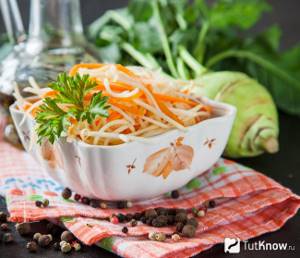
But many housewives still wonder how to eat kohlrabi cabbage - fresh, or is it better to heat-treat it just in case? Scientists from different countries have already answered this question - in a fresh way! Kohlrabi in this form better retains its taste and can be used as an ingredient in vitamin-rich dietary salads. Those who have already tried kohlrabi compare its taste with the taste of the stalk of white cabbage, but note that there is no unpleasant bitterness or pungency, the pulp is much juicier.
Below we will present you several recipes using kohlrabi cabbage:
- Vegetable stew with kohlrabi
. 300 grams of peeled kohlrabi cabbage, 200 grams of sweet red pepper and 150 grams of onion, cut into large strips. Fry the onion until golden brown, add pepper, then kohlrabi, salt to taste, add ground black pepper, and if desired, add a pinch of paprika. Pour in 80 ml of hot water and simmer over medium heat until the water has completely boiled away. You can serve with stewed pork or chicken and boiled rice. - Kohlrabi baked with potatoes and cheese
. Peel 500 grams of kohlrabi cabbage and 400 grams of potatoes, boil until half cooked, cool and cut into medium slices. Mix milk (100-150 ml) with egg, garlic clove, salt, ground black pepper and herbs - to taste. Grate hard or medium-hard cheese (200 grams) on a coarse grater. Place the potatoes and kohlrabi in a baking dish; pieces of cheese will add softness to the dish. Pour the milk mixture over everything, sprinkle with cheese and bake at 180 degrees for 40 minutes. For the cheese crust: Finally, increase the oven temperature. - Cabbage pancakes "Rosy kohlrabi"
. Peel kohlrabi cabbage (800 grams) and grate it on a grater with the smallest meshes, let stand for 2 minutes, drain off the juice formed at the bottom. Add an egg, 2-3 tablespoons of flour, a tablespoon of melted butter to the kohlrabi, mix thoroughly. Continuing to stir, pour in boiled water little by little until the dough reaches the consistency of thick sour cream, add salt. If desired, you can add crushed (finely chopped) garlic or sugar to make a main or dessert dish. Spoon the resulting “dough” onto a frying pan heated with vegetable oil, forming more or less even pancakes. Fry each side of the pancake for 1-1.5 minutes. Can be served with sour cream and herbs. - Vegetable diet salad with kohlrabi
. Cut kohlrabi (200 grams), carrots (200 grams), sweet peppers (100 grams) and sour apples (100-200 grams to taste) into thin strips. Season the resulting mixture with salt, olive or sunflower oil, sprinkle with lemon juice, and mix thoroughly. Can be eaten with cereals or consumed as an independent dish. - Salad with kohlrabi and pine nuts
. Peel kohlrabi cabbage (300 grams) and carrots (150-200 grams), cut into thin strips or grate on a Korean carrot grater, knead with salt. Add a chopped handful of parsley, sour cream, salt and pine nuts - to taste. For extra sweetness, you can add a couple of tablespoons of canned corn. To stir thoroughly.
Application in cosmetology

Due to its high concentration of nutrients, kohlrabi is successfully used in the cosmetics industry. Based on this product, rejuvenating masks are prepared for oily and aging facial skin.
Homemade beauty recipes
- Rejuvenating mask for oily skin. Peel a small head of kohlrabi and then chop it on a fine grater. Combine the cabbage mixture with 10 ml of honey and 10 g of fresh yeast, leave for 15 minutes. After this, pour 15 ml of freshly squeezed orange or apple juice into the mixture. Apply the mask to cleansed dermis for 20 minutes.

With regular use of the composition (2 times a week), the texture of the dermis noticeably improves, the complexion is evened out, and oily shine is reduced.
- Whitening mask for any skin type. Mix grated cucumbers and kohlrabi in equal proportions. Place the vegetable mixture on a piece of gauze. Apply the composition to the face for 15 minutes.
For oily skin, you can add 1 egg yolk, lemon juice (2 ml) and juniper essential oil (1 drop) to the mask. For those with dry skin, it is advisable to use boiled cabbage.
The mask has a moisturizing, whitening, toning and anti-inflammatory effect on the skin. Frequency of use: 1 time per week.
- Cleansing mask for problem skin. Ingredients: 50 g kohlrabi (grated), 20 g oatmeal, 10 ml sauerkraut juice, 5 ml sour cream, 1 drop jojoba oil. Preparation principle: pour 20 ml of boiling water over rolled oats, let stand for 5-7 minutes. Add the remaining ingredients to the steamed porridge. Apply the resulting composition to a cleansed face for 20 minutes (do not rub in). Use 2 times a week.

The composition is used to combat acne, comedones and blackheads.
- Softening mask for normal and combination skin. Pass kohlrabi (200 g) and carrot stalks (100 g) through a meat grinder. Squeeze juice from vegetables. Mix cabbage and carrot nectar with 7 ml of honey, 5 ml of homemade sour cream, 1 ml of olive oil. Apply the composition to the face in a thin layer. After 10 minutes, wash with warm water and lemon juice.
The product is used to eliminate excessive dryness of the skin, brighten the complexion, and reduce the number of acne.
- Nourishing mask for very dry flaky skin. Boil kohlrabi tops in homemade milk (7 minutes), then puree the leaves. Combine the resulting mass with a chicken egg and 10 ml of vegetable oil (olive, wheat germ, almond or jojoba). Before performing the procedure, it is important to thoroughly clean the skin (to avoid blockage of the sebaceous ducts). Apply the composition to a moistened face for 15 minutes. This product soothes irritated skin, lightens age spots (including bruises after an injury), and eliminates tightness in the upper layers of the dermis.
Cabbage juice is effective in the fight against vitiligo and warts. To reduce foci of depigmentation, freshly squeezed nectar is applied to the affected skin once a day (at night).
What can you cook?
Many chefs use kohlrabi for cooking. Modern housewives also prepare food from this vegetable. The product goes well with mushrooms, cheese and even exotic fruits.
Cabbage can be prepared as an independent dish or added to a meat or fish appetizer. Some housewives know how to make delicious pancakes from vegetables.
Note to housewives:
Kohlrabi cabbage - 13 of the simplest and most delicious recipes

